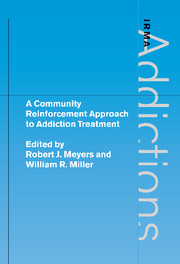Book contents
- Frontmatter
- Contents
- List of contributors
- Preface
- Acknowledgments
- 1 Developing the Community Reinforcement Approach
- 2 Practice and Promise: The Azrin Studies
- 3 The Treatment
- 4 A Comparison of CRA and Traditional Approaches
- 5 Community Reinforcement and Traditional Approaches: Findings of a Controlled Trial
- 6 CRA with the Homeless
- 7 CRA and Treatment of Cocaine and Opioid Dependence
- 8 Community Reinforcement and Family Training (CRAFT)
- 9 Summary and Reflections
- References
- Index
5 - Community Reinforcement and Traditional Approaches: Findings of a Controlled Trial
Published online by Cambridge University Press: 05 August 2012
- Frontmatter
- Contents
- List of contributors
- Preface
- Acknowledgments
- 1 Developing the Community Reinforcement Approach
- 2 Practice and Promise: The Azrin Studies
- 3 The Treatment
- 4 A Comparison of CRA and Traditional Approaches
- 5 Community Reinforcement and Traditional Approaches: Findings of a Controlled Trial
- 6 CRA with the Homeless
- 7 CRA and Treatment of Cocaine and Opioid Dependence
- 8 Community Reinforcement and Family Training (CRAFT)
- 9 Summary and Reflections
- References
- Index
Summary
This chapter contains the primary report of findings from our comparison of the Community Reinforcement (CRA) and traditional approaches, the methodology of which is described in Chapter 4. Our analyses focused on five main topics around which this chapter is organized:
Who were the clients we treated?
Were the treatments delivered as planned?
How well were treatment outcomes documented?
Did the compared treatments differ in effectiveness? (Questions 1–6 outlined in Chapter 4.)
Were there characteristics of therapists or clients who did particularly well in these treatments? (Question 7 from Chapter 4.)
Sample characteristics
Demographics
As described in Chapter 4, study participants completed a comprehensive assessment at intake that included measurement of numerous demographic characteristics, motivation for change, psychological functioning, drinking history, and current drinking practices. Basic demographic characteristics are presented in Table 5.1 for the total recruited sample (n =237) as well as for the clients who were defined as having received the intended treatment (three or more sessions) versus those clients who dropped out of treatment (two or fewer therapy sessions). As shown, the average client was a male around age 30, who had completed high school but not college. The majority of the sample were Hispanic, and only one in five clients was married at the time of study recruitment. Over 40% of the total sample was unemployed, with an additional 16% reporting only part-time employment.
Keywords
- Type
- Chapter
- Information
- A Community Reinforcement Approach to Addiction Treatment , pp. 79 - 103Publisher: Cambridge University PressPrint publication year: 2001
- 16
- Cited by



